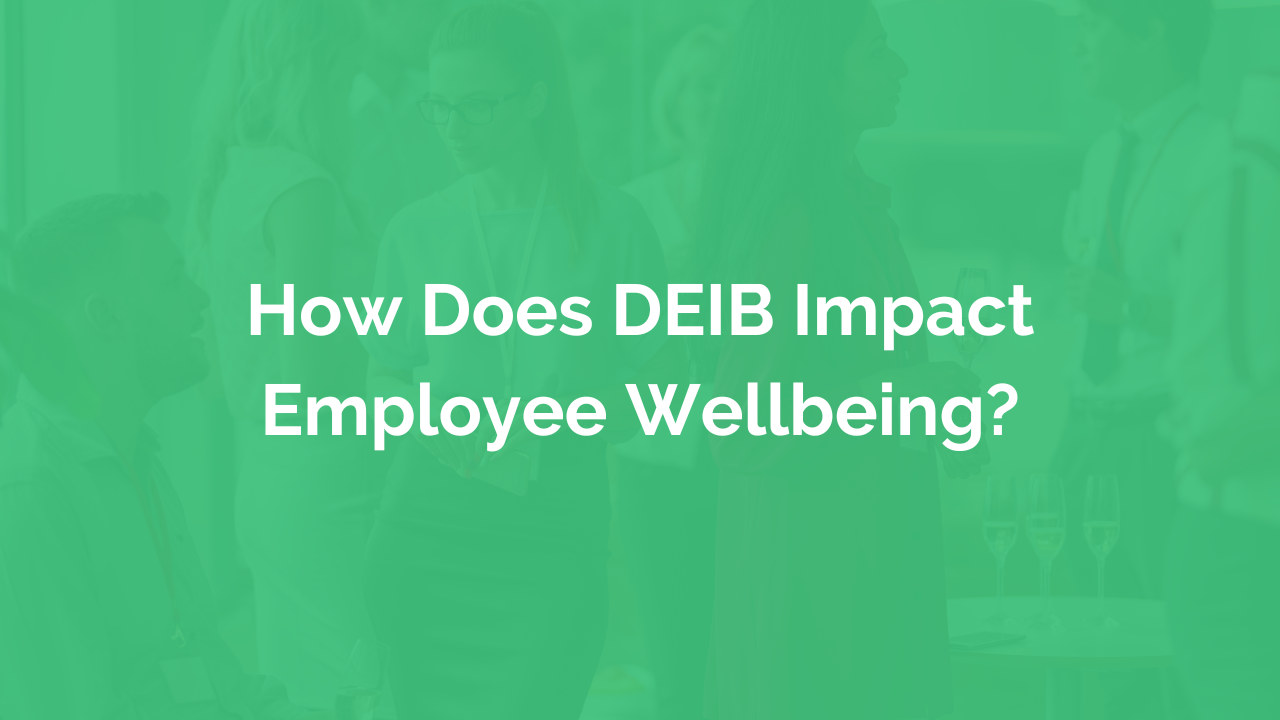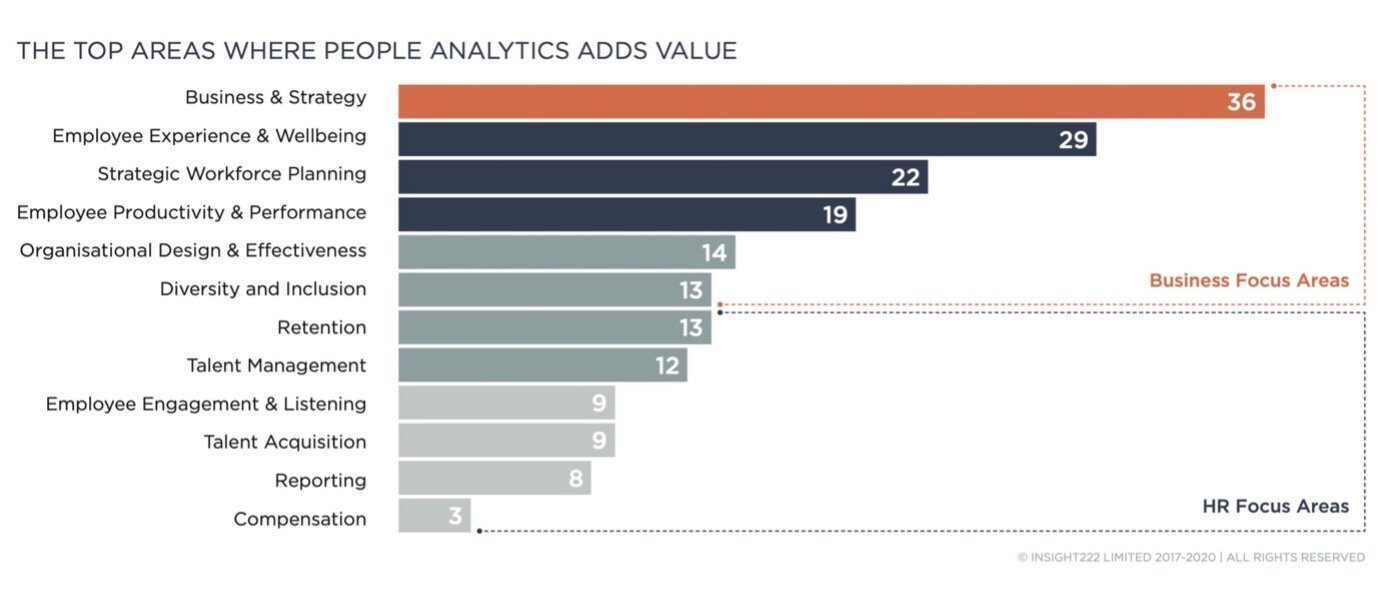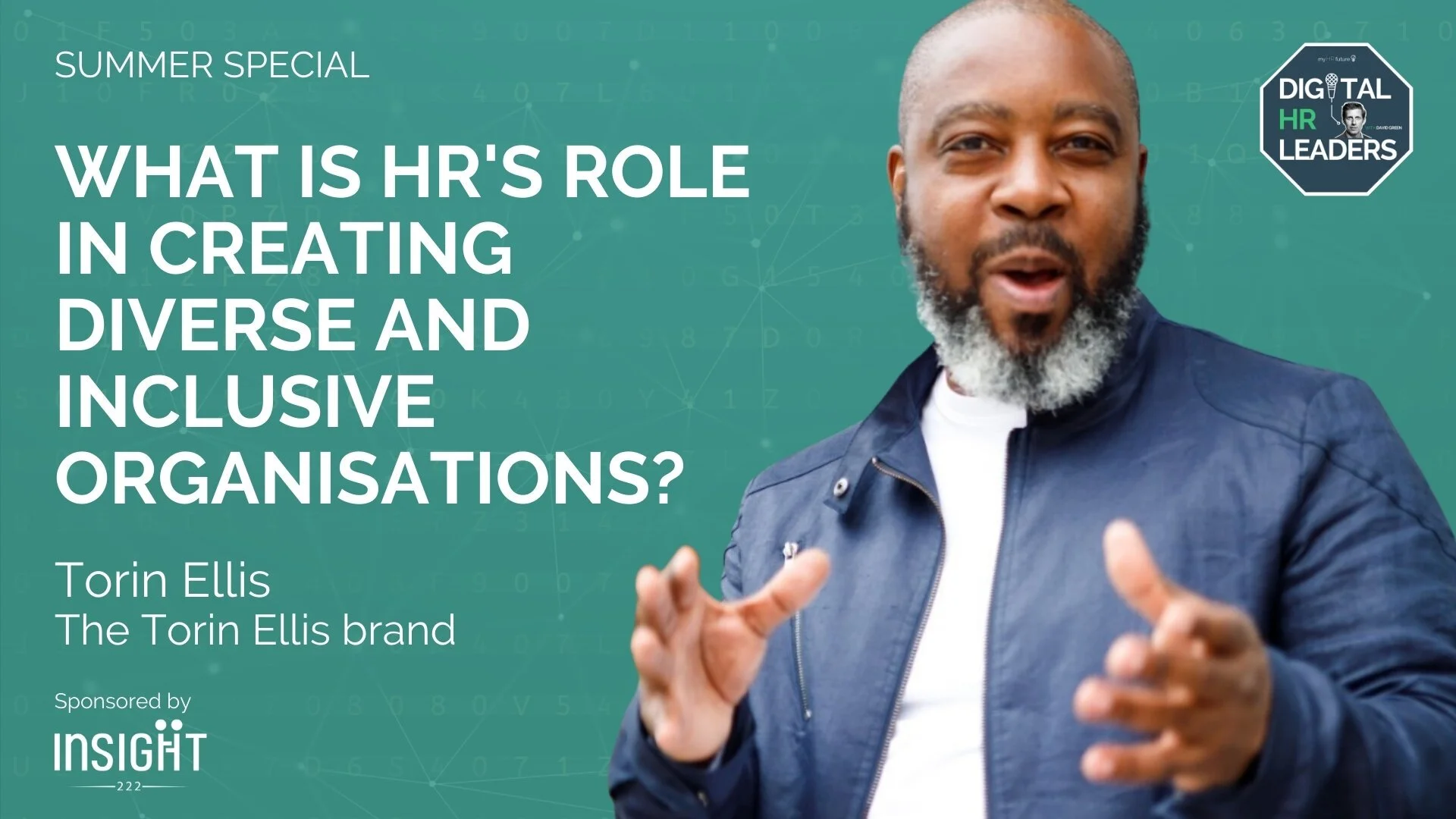How Does DEIB Impact Employee Wellbeing?
The focus of DEIB has only grown in the last few years. Because of that massive shift in how we view health and wellbeing in the workplace, people began evaluating their work-life balance and altering their priorities. Instead of only working for a paycheque and their financial wellbeing, people now prefer to work for a company that values people as individuals and cares about employee wellbeing. Moreover, our Insight222 People Analytics Trends 2022 report, Impacting Business Value: Leading Companies in People Analytics, showed that diversity & inclusion is one of the top three areas where people analytics adds the most value.
How Does a Diverse Work-Culture Impact Business Value?
Diversity in an organisation is not just hiring a wide range of different ethnicities but also includes employing people of a variety of ages, gender, sexual orientations, education levels, and cultural and religious backgrounds. Companies that hire a diverse workforce and encourage inclusion see that not only is there more cohesion amongst team members but productivity increases as well.
According to a McKinsey & Co. report, companies with the top quartile of racial and ethnic diversity are 35% more likely to have higher financial returns than their competitors in their industry. This is because a more diverse work culture produces a variety of results that ultimately benefit both the business and the employees.
Diverse Work Culture Breeds Creativity and Innovation
When your people come from multiple backgrounds, they approach problems differently. They bring more than one solution to challenges that may require unorthodox resolutions or problem solving. These different ways of thinking produce innovation and new interpretations of complex problem-solving and time-management tasks.
DEIB Attracts Top Talent
Because so many people want to work for an organisation that offers learning and growth opportunities, with 59% of millennials stating its importance when job searching, when people see room for advancement in an organisation and a willingness to create an atmosphere of belonging and growth, they are more likely to apply, work hard to see the organisation succeed, and grow with the business.
Inclusion Offers an Edge Over the Competition
When people feel included, they are more open to expressing their opinions and where they may see issues in processes or policies. Because of diversity, businesses can draw from employee knowledge of customer needs in a completely unique manner. New ways of thinking and considering the impact of opinions and statements results in a greater social awareness. Not to mention, a diverse workforce prevents costly mistakes from being made from limited information or insight and biased notions.
Nurturing Mental Health Builds Employee Wellbeing
An environment that encourages inclusion and celebrates individualism creates, for the employee, a sense of worth, appreciation and value. They experience stability that eliminates the effects stress can have on a person's mental and physical health.
How Does People Analytics Affect DEIB?
Our Insight222 People Analytics Trends 2021 report confirmed that people analytics teams have been helping solve major HR pain points for some time, including societal and economic issues. People analytics leaders cited "Diversity & Inclusion" and "Employee Engagement & Listening" as the top two areas where people analytics added the most value to their company in 2021.
Continuing into 2022, little has changed in the value people analytics offers. For the last two years in a row, DEIB has been found to remain one of the top priorities for people analytics teams and one of the main areas where people analytics adds value. It has been observed that people analytics offers valuable insight into not only the current level of the DEIB within the company but can also see into ways of overcoming challenges and improving on them.
How Does Technology Help People Analytics Measure DEIB?
Technology has made significant advancements that assist people analytics teams in collecting and measuring the status of diversity and inclusion within the organisation.
There are four categories where DEIB technology supports people analytics:
Talent Acquisition - including candidate sourcing, screening, interviewing and selecting.
Development and Advancement - including learning and development, mentorship and career management, performance management, high-potential selection, and leadership development.
Employee Engagement and Retention - including employee experience, communications, listening, and wellbeing.
Analytics - including DEIB analysis (e.g. DEIB dashboards and pay equity), DEIB business case analysis (e.g., data that shows the return on diversity and inclusion investments), and employee resource group (ERG) management and analysis.
How Are Leading Companies Focusing on Diversity and Inclusion?
The very nature of diversity and inclusion is to focus on all people. Leading companies have learned the importance of investing in a diverse workforce. They understand that a company culture that celebrates and implements DEIB will have happier team members who are able to better contribute to the business and support the business needs.
In addition to this, an important finding to note from our Insight222 People Analytics Trends report was that all Leading Companies have a behavioural scientist as part of their people analytics teams. These individuals use scientific approaches to understand employee sentiment and test suitable interventions that the organisation can make to improve employee experience in areas such as psychological safety, belonging, and fairness. This is important to reveal the insights to inspire action in DEIB.
Microsoft
Microsoft is an interesting case study as a company that focused heavily on D&I. Taking the time to ask employees and leaders of Black and African American communities, Microsoft determined specific actions to take regarding social injustice and implemented them to make meaningful improvements.
They did this by improving their company culture with investment in DEIB to increase diversity among managers, senior individual contributors, and senior leaders. They also engaged in their ecosystem and partnered with suppliers owned and run by their communities. And lastly, they strengthened communities through data, technology, and partnerships to address the safety and wellbeing of employees and their communities.
ChartHop
Yet another example, and a company, whose owner we have featured on the Digital HR Leaders podcast, at ChartHop, they experienced a quick expansion that they hope wouldn't affect their employees' wellbeing and inclusion.
They launched four ERGs within their organisation that were specific committees focusing on an individual community. From these committees, Ivori Johnson, Director of DEIB at ChartHop, stated:
"These are not just places where our employees can go find a safe space but are also places to build community and just learn more. So, for even anyone that does not identify as being a part of that community, they can join to just learn and be an ally."
They also introduced a DEIB council to act as a governing body and look across the company to identify what is most important to their people and any gaps as a result of their findings. This council opened communication with the executive team so everyone knew what was happening.
Lastly, they created an employee-volunteer programme called CharTalk, where every month, employees come together to talk about heavy topics. This safe space allows for an employee to feel safe and included, which is vital to the company's people management.
How to Become a More Open and Welcoming Business/Workplace
There needs to be one answer or pathway for a company to become more open and welcoming, building employee wellbeing. But one or two steps to improve how people are perceived, included and offered equal opportunities go a long way to becoming more welcoming to all people. Consider:
Communicating With Stakeholders – all stakeholders need to understand the reasoning behind the efforts. Let them know the reasons why inclusion is beneficial and drives employee wellbeing as well as company growth.
Learning and Development – it is easy to hold on to age-old beliefs, but as the last few years have shown us, there were a lot of barriers preventing DEIB. Discovering where policies have been failing and learning where practices can be modified will move the needle in the direction you want to go.
Taking Action – avoid becoming the company that talks about DEIB yet has failed to take any steps to change the way people are sourced, promoted, and included within the company. Every movement is a movement forward. Take appropriate steps, even if they are small steps.
Listen, Discuss, Implement
It is common knowledge that employee wellbeing benefits both the individual and the business. Not as commonly known is the impact DEIB has on employee wellbeing. When employees are included and feel their voice matters, they will be engaged in the organisation's mission, striving to do all they can to assist the company reach those goals.
CHROs, HRBPs and business leaders are working hard to learn about DEIB, employee wellbeing and how to combine the two to make their company competitive in the competitive labour market we are all facing today.
Our Insight222 People Analytics Program® develops the knowledge and capabilities of people analytics leaders and their teams. It is the only networking and learning program in the world, dedicated to people analytics leaders and delivered by ex-practitioners.
Through a variety of learning and networking solutions, Insight222® enables people analytics leaders and their functions to deliver greater value and improve their impact. Sign up today and gain the insights and networking opportunities to optimising your team today!









